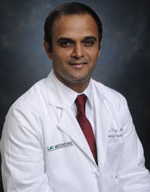Dr. Surya Bhatt is one of four recent CCTS KL2 awardees, who says he heard about the research opportunity through the Division of Pulmonary, Allergy and Critical Care Medicine where he works. “Three different people sent me an email about it in one day, because they thought I’d be a good candidate,” he recalls.
“I wasn’t getting the full time I needed to do research, and this was a timely opportunity to have my time fully protected.”  Surya Bhatt, MD, Assistant Professor, UAB Division of Pulmonary, Allergy and Critical Care Medicine Medical Director, Pulmonary Function and Exercise Physiology Lab
Surya Bhatt, MD, Assistant Professor, UAB Division of Pulmonary, Allergy and Critical Care Medicine Medical Director, Pulmonary Function and Exercise Physiology Lab
The title of his research project is, “Diastolic Dysfunction and Pauci-inflammatory Acute Exacerbations of Chronic Obstructive Pulmonary Disease.” His goal is to try and phenotype acute exacerbations of chronic obstructive pulmonary disease, or COPD. While the majority of exacerbations are thought to be caused by viral or bacterial infections, up to one-third are from an unknown cause.
“All are treated with steroids or antibiotics, which is often not very successful,” Bhatt says. Bhatt says some of the exacerbations may be related to cardiac issues, as approximately 40 percent of stable COPD patients have impaired relaxation of the heart. “We have shown previously that if you have an irregular heartbeat, you’re more likely to have an exacerbation of COPD,” he says. “We put these things together and said, maybe the exacerbations are due to cardiac dysfunction.”
As possible evidence of this, Bhatt says, if COPD exacerbations arise only from the lung, there should be inflammation in the lungs and blood; however it has been shown that there is no lung inflammation in about 20 percent of these patients.
Bhatt and his research team are recruiting patients during acute exacerbations to look for systemic and pulmonary inflammation via blood draw and exhaled breath condensate analyses. In addition they conduct echocardiography to assess diastolic dysfunction of the heart and lung ultrasound to look for fluid in the lungs. Ideally, they would study patients both in the stable phase and during a subsequent exacerbation, but because that is not feasible, they are repeating the studies 35 days post-exacerbation to compare with findings during acute exacerbations.
“We’ve found so far that patients who have low inflammatory status during exacerbation have a considerably higher rate of cardiac dysfunction,” Bhatt says. “This has two potential implications: We could try and modulate these patients’ diastolic dysfunction; or we could treat them differently from the usual prednisone and antibiotic therapy, such by using beta blockers or diuretics, for example.”
Bhatt suggests that alternative treatments to antibiotics and steroids might avoid the side effects those drugs can cause, including muscle weakness, high glucose levels, and reduced immunity causing susceptibility to infections. “While considerable efforts have been made toward phenotyping stable COPD, this is one of the first studies attempting to phenotype acute exacerbations.”
He will use a portion of the time dedicated to this research to learn about cardiac magnetic resonance imaging (MRI) with Dr. Thomas Denney at Auburn University, part of the CCTS Partner Network. Bhatt says he also hopes to complete a Master of Science in Public Health degree in Clinical and Translational Science. He is mentored by Dr. Edwin Blalock and Dr. Mark Dransfield, both leading investigators in COPD research.